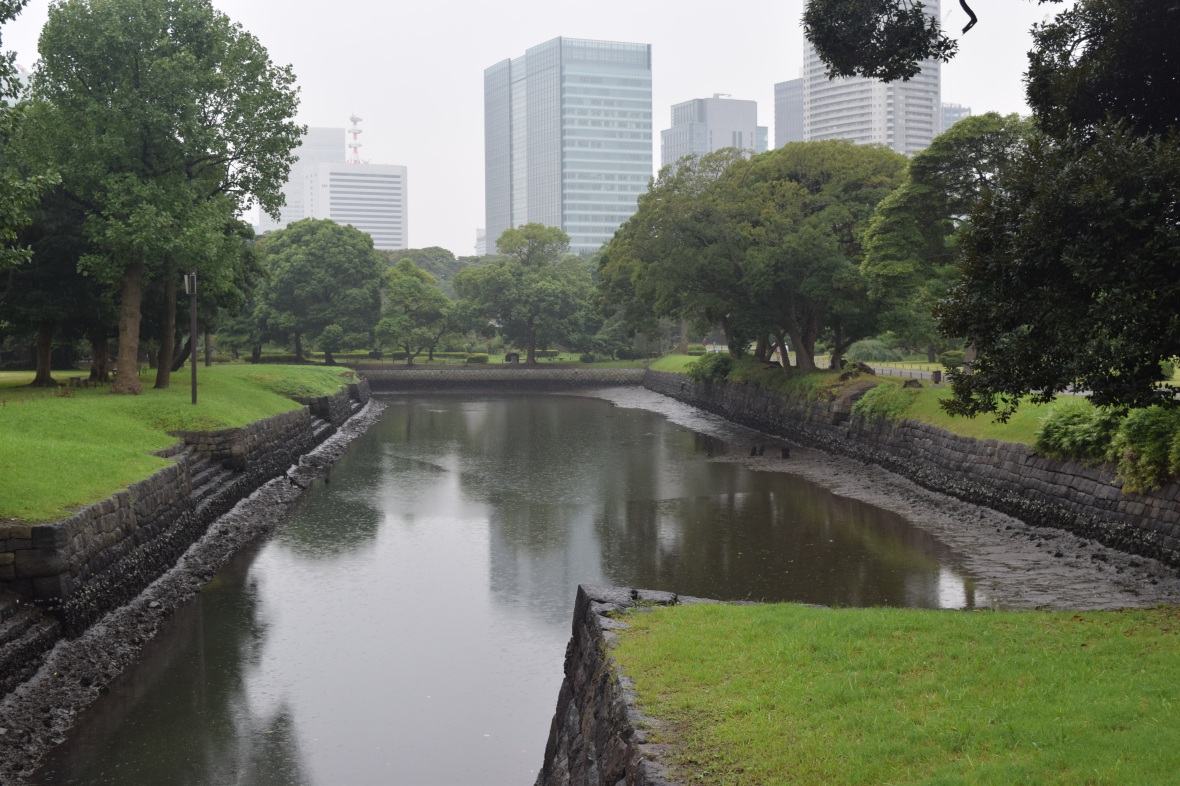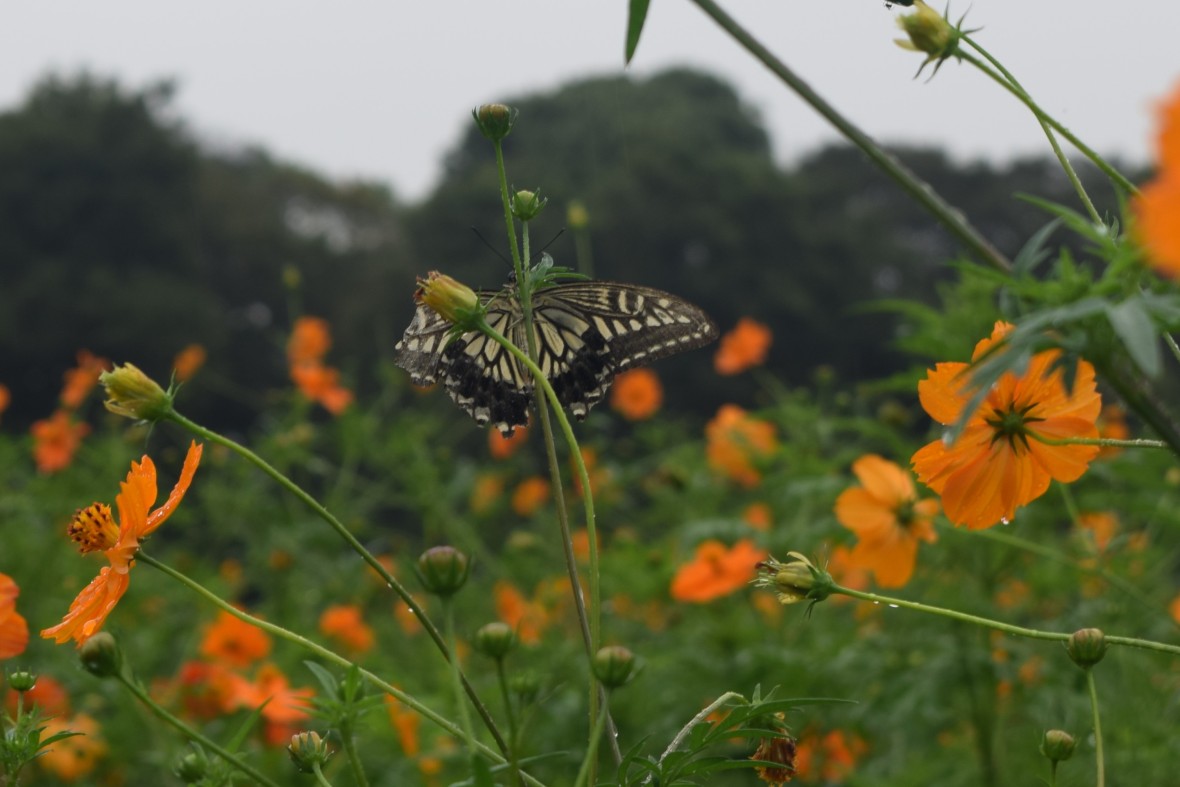Tokyo’s Hama Rikyu Garden in the Rain
Our first day in Tokyo this past September, Judy and I visited Hama Rikyu Garden. Some four hundred years ago this garden consisted of a shallow pond and marshland used by feudal lords for duck hunting. Today, however, it is surrounded by the skyscrapers of downtown Tokyo.

As a landscape garden, Hama Rikyu is still built around saltwater ponds and moats which rise and fall with the tides. It’s located across the Sumida River from the old central fish market.
The day that we visited ranged from misty to rainy and so the skies were rather gray.

One of the landmarks of Hama Rikyu is a three hundred year old pine tree known, not surprisingly, as the Three Hundred Year Pine. (It’s actually three hundred and eight, but let’s not quibble.) All those stilts make me think of an old man and his walker. I sometimes wonder if this sort of pruning is really good for a tree, but it’s hard to argue with the longevity of this specimen.

Fields of Orange Cosmos (Cosmos sulphureus) make Hama Rikyu fairly unique among Japanese gardens. Masses of colorful flowers are exceedingly rare here during August and September.

I do love Orange Cosmos. This was an unusually tall variety.

Even in the rain, the Cosmos attracted butterflies.


The bark on these Black Pines (Pinus thunbergii) is really striking.

A view of the tidal pond.



A wooden bridge leads to the tea house on a small island.

Another view of the tea house. It’s more of a cultural than a culinary experience (unless you love cold green tea and rather bland Japanese sweets). However, you don’t want to miss the views from the island or connecting bridges.


Hama Rikyu is a good place to meet up with various aquatic birds.

Especially Egrets.


And Herons.

If you walk along the Sumida River you will come to a sluice gate that controls the flow of water into and out of the garden.

Around the corner from the sluice gates you can pick up a water bus to take you back up the river.

Which is exactly what we did.
More next time about our rainy day in Tokyo.





How excellent! It is remarkable how much it looks like one would expect. I mean, without knowing where it is, one might guess that it is near Tokyo because of the remarkably distinctive style. The skyscrapers in the background help to.
All that cloud pruning kind of gives it away.
Even in the rain, it looks a beautiful place to visit, it looks so peaceful away from the hustle and bustle of the city.
I would say it was worth visiting, even in the rain.
I’m always amazed at trees as old as the Three Hundred Year old Pine … The stories that tree could tell! I love the orange Cosmos … that would be a winner for any park or garden!
I also love old trees. They have great presence.
It looks like a serene oasis in the middle of the city. I have never heard of this garden before and am oleased to see that sea of orange Cosmos. Free planting is something rarely seen in the formal parks and temple gardens. 🙂
Very true. In many ways this is an unusual public garden for Japan.
I like the park-like feeling of this garden and can imagine enjoying a long afternoon there.
There’s definitely enough to see and enough space to spend a leisurely few hours.
Excellent photos despite the weather. The grey blanket over the garden makes it seem even more serene. It does seem odd to have such a large patch of color in a Japanese garden but who cares if you get to see the butterflies. I am always surprised to see birds that are common around here when in other countries.
The light rain and mist seemed to add a hush to the garden.
That gray day certainly highlights the beauty of the garden well. Lovely photos–thanks for sharing the garden.
We would have appreciated a little less wet.
Beautiful and serene.
A lovely place & the cosmos were a nice surprise. Those feudal lords must have been very good hunters because there wasn’t a single duck to be seen.
Good point!
Stunning photos!
Thanks!
I love the juxtaposition. The calm green park seemed in the photos to be a quiet spot, set apart from the world, yet the skyscrapers and noise of Tokyo were all around. Plus you seem to have had the park all to yourself. Was it the rain that kept people away or were the photos taken to avoid seeing others? It can’t be that deserted very often, not in a city as crowded as Tokyo. But lucky you if you had the garden all to yourself.
I haven’t quite decided what I think about gardens surrounded by skyscrapers, Pat. It’s an interesting juxtaposition, and Tokyo is so packed that the gardens are a real oasis. But, but, but – I still find it jarring. Of course the Lurie and the High Line are surrounded by tall buildings, so it’s not just Japan. There weren’t many people, but there were a few; I exclude them from photos unless they add something.
I like the contrast between the serenity of a garden and the noise and confusion of the city that surrounds it. I’d like it equally, I think, if the garden weren’t a spot of serenity but was livelier, more in tune with Martha Schwartz’s Bagel Garden, for instance. There’s an idea lurking here that I can’t quite put my finger on, but it has to do with the relationship between gardens and the contemporary world. I don’t like the idea that a garden can work only in isolation from its surroundings, whether those surroundings are actual or contextual. Not sure if I’m making myself clear… as I say, I can’t quite articulate what I mean. But this seems to be an important point about gardens today. They need to be more than retreats. Or at least I want them to be more than that. Or quoting Ian Hamilton Finlay, “Certain gardens are described as retreats when they are really attacks.”
That’s an interesting observation. I wonder when a garden is an attack. Maybe if it has lots of spiky cacti?
That’s beautiful, even in the rain.
Yes, we thought so.
“Some 400 years ago…” puts it into perspective, doesn’t it? That meadow of Orange Cosmos is stunning!
I loved it.
I love that 308 year old pine! All the pine seem to have a different look to them, really. And the orange cosmos are pretty. I grew them once, but I prefer the pink, red or white ones in my garden.
I think the pines in Japan are mostly species that are not common in the US. Plus there’s all that cloud pruning.
Looks like such a peaceful place – I would have enjoyed a stroll through that garden. What strikes me the most is the stark contrast between the tranquil garden and the modern skyscrapers in the background.
I find that contrast to be really energizing, it’s the same effect at the Lurie Garden in Chicago.
Seems so wonderful in the photos, must be amazing in person. The way the stilts support the Three Hundred Year Pine seems especially tasteful and respectful.
The stilts certainly make the tree more interesting.
Hello Jason, I think that’s the first time I’ve seen masses of flowering plants in a Japanese garden on that scale, it’s typical here but must be very unusual in Japan. The teahouse is beautiful and I love the way the rocks line the shore line.
Thank you for the tour. Once again a beautigul garden spot to visit and I have often found Japanese gardens to be very peaceful, even in large surrounding cities. I suppose that is the point. Agree with you about the orange cosmos, wow.
The Cosmos add a dash of excitement.
That ancient tree is wonderful, I liked your description of the supports as a walker. The orange cosmos is wonderful! Lucky you seeing all those butterflies and water birds.xxx
It added much liveliness to our walk through the garden.
Pingback: Tokyo haven… | Old School Garden
Awesome post! Check out some of mine! duckhuntingfordummies.wordpress.com